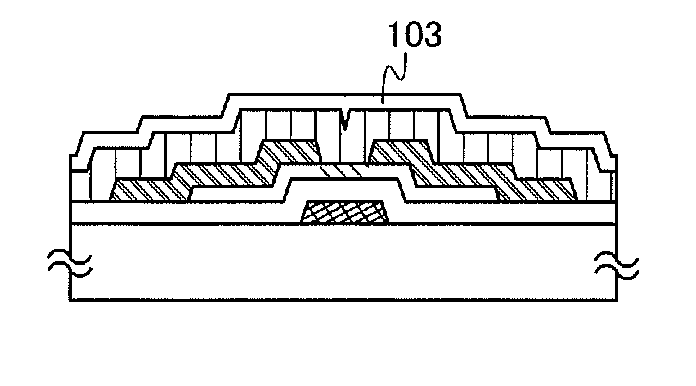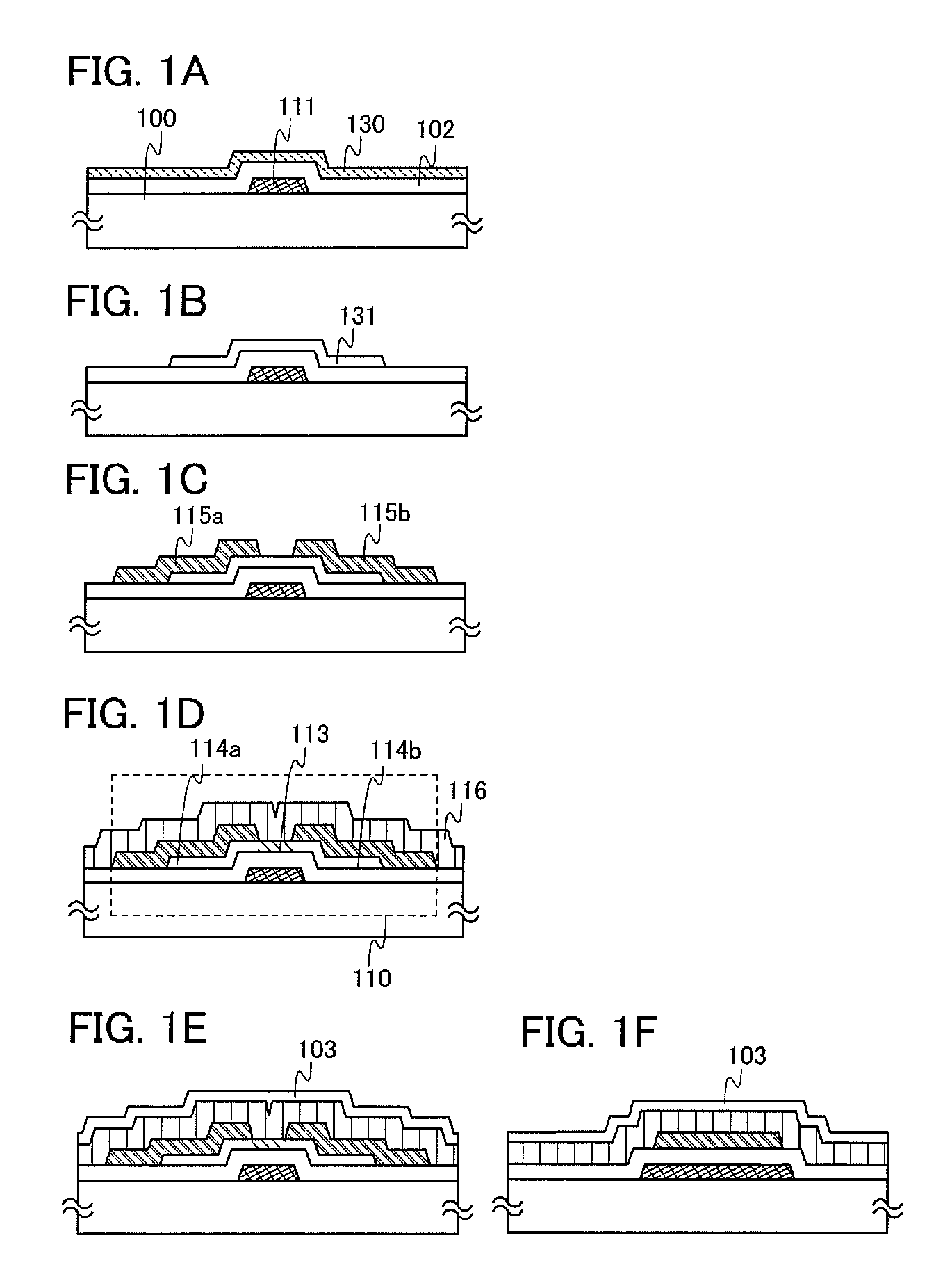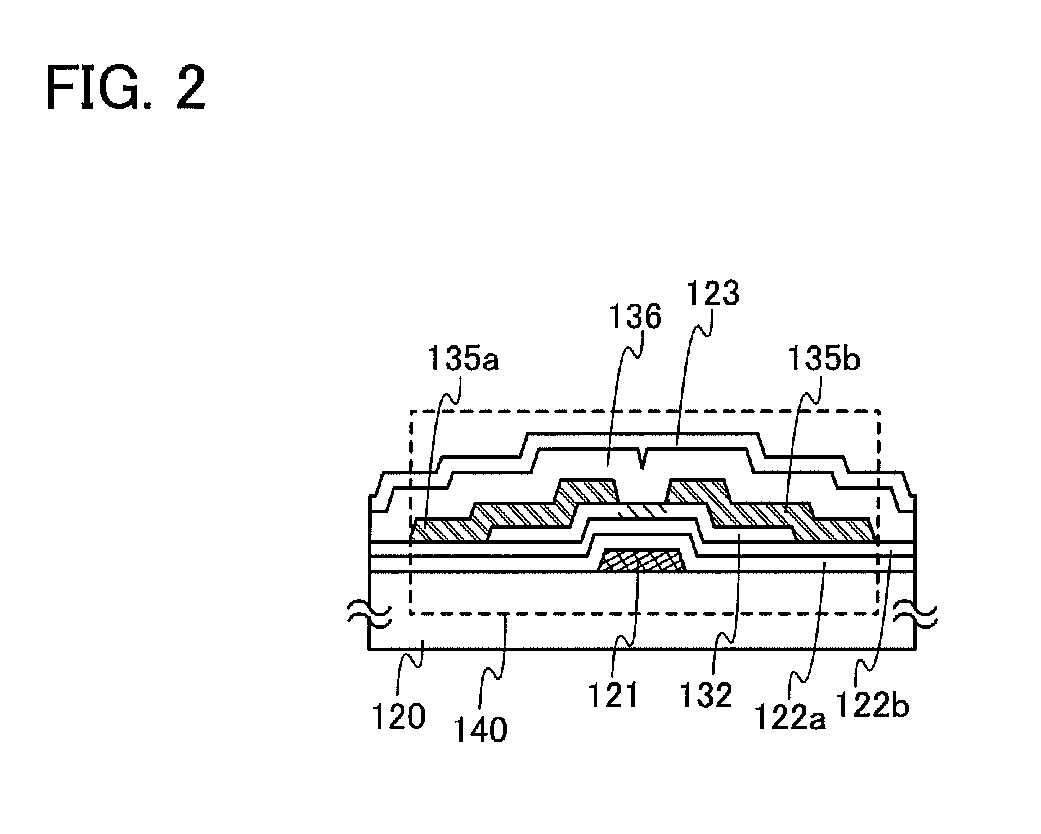Semiconductor device
a technology of semiconductor devices and semiconductors, applied in semiconductor devices, capacitors, electrical apparatus, etc., can solve the problems of low on-off ratio of transistors and the difference in stoichiometric composition of oxide semiconductors, and achieve stable operation of circuits, improve aperture ratios, and improve the effect of transistor on-off ratios
- Summary
- Abstract
- Description
- Claims
- Application Information
AI Technical Summary
Benefits of technology
Problems solved by technology
Method used
Image
Examples
embodiment 1
[0047]In this embodiment, a semiconductor device which is one embodiment of the present invention is described.
[0048]First, a transistor which can be used for the semiconductor device of this embodiment is described with reference to FIGS. 1A to 1E.
[0049]A transistor 110 illustrated in FIGS. 1A to 1E is an inverted staggered transistor having a bottom-gate structure.
[0050]Although the transistor 110 is a single-gate transistor, a multi-gate transistor having a plurality of channel formation regions may also be used as necessary.
[0051]First, after a conductive film is formed over a substrate 100 having an insulating surface, a first photolithography step is performed, so that a gate electrode layer 111 is formed. Alternatively, the gate electrode layer 111 may be formed by processing the conductive film with use of a resist mask formed by an inkjet method. In the case of forming a resist mask by an inkjet method, the manufacturing cost can be reduced because a photomask is not used.
[...
embodiment 2
[0166]In this embodiment, a transistor that can be used for the semiconductor device described in Embodiment 1 and is different from the transistor in Embodiment 1 is described.
[0167]FIGS. 10A to 10D illustrate cross-sectional structures of a transistor of this embodiment. A transistor 220 illustrated in FIG. 10D is one mode of a transistor having a bottom-gate structure called a channel-protective type transistor (or a channel-stop type transistor). A process for manufacturing the transistor 220 over a substrate 200 is described below.
[0168]First, a conductive film is formed over the substrate 200 having an insulating surface, and a first photolithography step is performed, so that the conductive film is processed into a gate electrode layer 202.
[0169]The gate electrode layer 202 may be formed using a material similar to that for the gate electrode layer 111 and may have a single-layer structure or a stacked-layer structure of a plurality of layers.
embodiment 3
[0191]In this embodiment, a transistor that can be used for the semiconductor device described in Embodiment 1 and is different from the transistor in Embodiment 1 and Embodiment 2 is described.
[0192]FIGS. 11A to 11D illustrate cross-sectional structures of a transistor of this embodiment. A transistor 320 illustrated in FIG. 11D is one mode of a transistor having a bottom-gate structure. A process for manufacturing the transistor 320 over a substrate 300 is described below.
[0193]First, a conductive film is formed over the substrate 300 having an insulating surface, and a first photolithography step is performed, so that the conductive film is processed into a gate electrode layer 302.
[0194]The gate electrode layer 302 may be formed using a material similar to that for the gate electrode layer 111 and may have a single-layer structure or a stacked-layer structure of a plurality of layers.
[0195]Note that a resist mask may be formed by an inkjet method. In the case of forming a resist...
PUM
 Login to View More
Login to View More Abstract
Description
Claims
Application Information
 Login to View More
Login to View More - R&D
- Intellectual Property
- Life Sciences
- Materials
- Tech Scout
- Unparalleled Data Quality
- Higher Quality Content
- 60% Fewer Hallucinations
Browse by: Latest US Patents, China's latest patents, Technical Efficacy Thesaurus, Application Domain, Technology Topic, Popular Technical Reports.
© 2025 PatSnap. All rights reserved.Legal|Privacy policy|Modern Slavery Act Transparency Statement|Sitemap|About US| Contact US: help@patsnap.com



